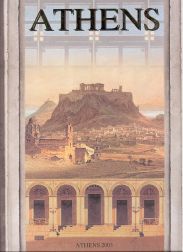New Castle, DE: Oak Knoll Press, 2003. 4to. Cloth w/dust jacket. 540 pages. First edition. In commemoration of the 2004 Summer Olympics in Athens, twenty outstanding scholars have set about to celebrate, with prose and illustration, 2,500 years of Greece's most famous city. This unique work, with its collection of rare drawings and photographs, explores the historical Athens from its Classical beginnings to the city's rebirth as the bustling, modern capitol of the Greek nation..... READ MORE
Price:
$65.00
other currencies
Order nr. 71774
Athenian Classical Architecture
The unrivalled works of Athenian classical architecture are the most visible aspect of a wider historical phenomenon which has had a universal and lasting impact. Other aspects of the same phenomenon, perhaps more important but less obviously visible, were literary endeavour, the birth and evolution of drama as an elevated form of creative art, the systematization of philosophy and the development of political systems and institutions. Consequently the best way to understand Athenian architecture is to consider it as just one part of the whole; and it is likewise easier to understand the way it developed if we look at it in the context of the historical and artistic background from the late seventh or early sixth century B.C. However, space does not permit more than a selective survey of the subject: this chapter covers the main types of temples and other buildings, and also certain topics relating to innovation, evolution and influences. Before the sixth century B.C. the Acropolis still contained within its Cyclopean walls some buildings that had survived from the Mycenaean period. In the middle was the sanctuary of Athena with a large altar and a brick temple (of the Late Geometric period) with wooden columns in the sekos and pronaos. Some scant remains of it were found in 1885 a few metres south of the Erechtheion. It remained in use until 530 B.C., perhaps with a new roof, and at some point it came to be known as the Old Temple of Athena; later, however, that name was applied to the temple built on the same site under the Peisistrateidai.
The Asty ('City'), a maze of winding streets teeming with life, was in early antiquity a dense huddle of buildings occupying a belt about five hundred feet wide all round the Acropolis as well as the hill of the Areopagus (Areios Pagos) and its lower slopes - an area bounded roughly by modem Polygn6tou, Lysfou, Trip6dhon, Vakhou, Dhionisfou Areopayitou and Apost610u Pavlou Streets. The Agora or civic centI1l: was to the north of the Church -of Hagios Nik6laos Rangavas. Bordering it, just outside the boundaries of the Asty (in the area of modem Kirristou Street), was the area set aside for official Panathenaic religious festivals and festivals of games, which were the foundations of the Athenians' social and cultural identity. The great landowners controlled political affairs while another up-and -coming class, that of the artisans and merchant shipowners, dominated the city's commercial life and pushed steadily to acquire an equally influential role in politics. These two classes had both the means and the will to impose their taste on the development and beautification of public places in Athens, especially the religious sanctuaries, and such work kept all sorts of artists and craftsmen in almost continuous employment: potters, painters, tilers, sculptors, metalwork- ers, braziers and others. The kinds of project on which they worked remained unchanged during several peri- 'Jds: sundry types of funerary monuments, sundry types of votive tripods, sumptuous lustral basins, ritual tables, altars, sundry types of statues and so on, but the modes of artistic expression varied and were constantly evolving.
Before the middle of the seventh century, as a result of a long succession of achievements (e.g. in ironworking and writing) and social progress in all fields, aided by favourable geopolitical conditions (friendly relations and commercial dealings with Egypt), the whole of Greece experienced an unprecedented surge of economic, demographic and cultural development. In building construction, the first appearance of tiles brought about a revolution in architecture: the steeply-pitched roofs covered with thick vegetation became a thing of the past, together with the buildings they had covered. The new roofs sloped very gently, to prevent the tiles from slipping, yet they were completely waterproof thanks to the size and perfect fit of their component parts. The shape and size of tiles were highly standardized, which meant that the design of the whole building had to conform to stricter specifications, and that in turn led to the crystallization of the forms and pro- portions of a new style of architecture, the Doric orner, which first took shape in wooden buildings (Fig. 3) but was very soon adapted for use with stone. Even then, however, stylized imitations of the components that had been devised as structural elements in wooden buildings and had become established as architectural motifs persisted as features of the Doric style.

